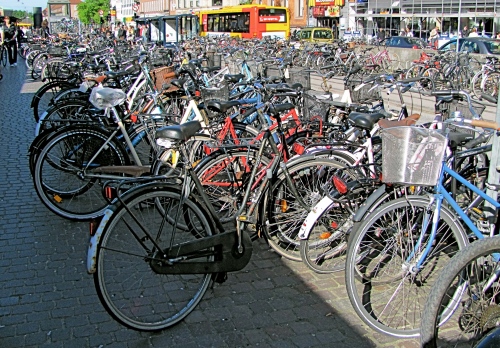I have recently been exploring the development of an area in southwest Copenhagen that was once home to the manufacturing facilities of Carlsberg Breweries, one of the world’s largest brewery groups. The master plan for this site employs many of the latest ideas in the field of urban planning, seeming to serve as a model, at least on paper, for how the development of former industrial sites should proceed.
Designed by Entasis Architects, a relatively small Copenhagen-based firm that won Carlsberg’s international ideas competition for the site’s development, the plan aims to transform this 74-acre site in extraordinary ways. The new city district will be compact, characterized by a variety of users and a variety of functions. Development will be transit-oriented, with plans to renovate and even relocate the nearest train station and with provisions for plenty of bicyclists and pedestrians (planners anticipate a transportation modal split somewhere around one-third motor vehicles, one-third public transport, and one-third cyclists and pedestrians). Public gathering spots and other shared areas will abound, and the spaces between buildings will receive more attention than will the buildings themselves. And the site’s beautiful historic buildings, many of which are legally protected by Denmark’s Heritage Agency, will be preserved and integrated almost seamlessly with the new construction. The site plan will modernize the medieval European-style compact city that has become so popular in today’s urban planning world.
Of course, the development of the Carlsberg site has enjoyed incalculable advantages that have helped to make such a remarkable master plan possible. For one, rather than allowing the area surrounding its former manufacturing facilities to grow derelict, Carlsberg Breweries has played an active role in determining the future of the site. Plans for redevelopment began even before Carlsberg had transferred production to its new facilities, ensuring as smooth a transition as possible between industrial area and new city district. The site will continue to use the Carlsberg brand, ensuring not only the continued involvement of Carlsberg Breweries but also imbuing the area with 160 years of industrial history. And the site’s location in Copenhagen, a place where progressive planning ideas have become mainstream and where citizens tend to engage constructively in planning processes, certainly did not hurt.
Perhaps most notably, Carlsberg has launched another ideas competition, this time to find suitable temporary public spaces to create and maintain vibrant city life during the interim period between industrial area and city district. Carlsberg’s developers have evidently realized that well-designed buildings and well-planned city blocks are worthless without people. The temporary public spaces are intended to inject life in the Carlsberg area from the beginning of the development process, to ensure that the district will have a long tradition of public life and social integration. Three proposals have been awarded a total of 7 million DKK (about $1.2 million USD) to construct 25,000 square meters of outdoor public facilities; the first of these spaces opened in June, and Carlsberg has already begun to promote a number of public events in the area.
If the site’s master plan represents a “revolution” in modern city planning for its ability to translate age-old ideas into modern language, then the site’s temporary public spaces represent a revolution in the battle against urban decay. This initiative, combined with Carlsberg’s early involvement in the redevelopment process, suggests that it is possible to prevent industrial decay through masterful master planning and intelligent urban design.
Yet the tragedy of the Carlsberg site is that it too may become another reminder that in the field of urban planning, as with so much else, money rules all. Construction has been stalled indefinitely, as developers recover from the financial crisis and recognize that their investment horizon may be much longer than initially anticipated. Developers have already begun to reevaluate whether relocating the nearby train station, once an integral component of the transportation plan for the area, is worth the enormous expense. It is unclear what will happen with the Carlsberg site, but it now seems unlikely that the master plan will be realized in its entirety.
And so the Carlsberg project affords hard lessons about the reality of urban redevelopment projects. Even with all of the advantages in this case, Carlsberg’s developers have been unable to transition from master plan to on-the-ground reality. I do sincerely hope that they will manage to create something resembling Entasis’ plan; I would like to believe that it is possible to plan such an appealing, vibrant, magical urban space.



